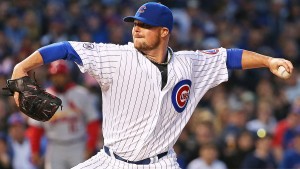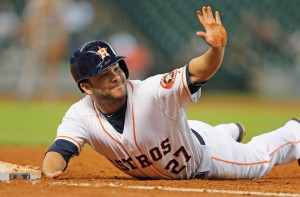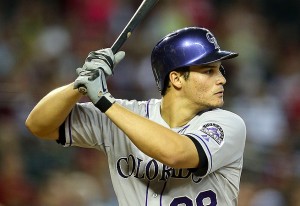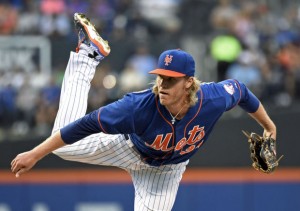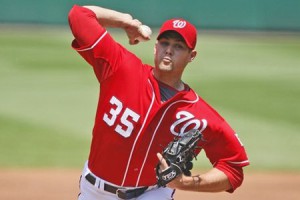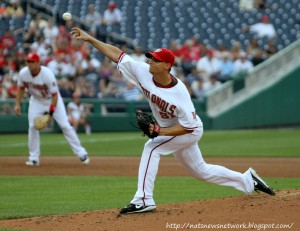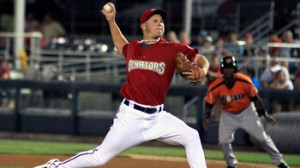Even though there’s still about 20 “starting pitchers” still on the FA market, none of them really project as anything more than a 5th starter competition or a MLFA signing at this point in the off-season, so I thought it was high time to break out my 2017 Rotation Rankings. (Here’s a link to last year’s rankings)
This is not a ranking of 2017 projected performance, nor a WAR ranking from last year, nor anything statistical in nature. This is me looking at individual players and gauging the overall “strength” of the rotation, with subjective rankings then applied. This is also a lot of me asking, “Who would I rather have as a fan?” type questions; would your rather have Chicago’s 1-2-3 or New Yorks? This starts with the identification of the roughly 20 or so best pitchers in the league right now, calling them “Aces,” then looking at those who are just a notch below an Ace, and going on down in order to think about the overall strength of a rotation. There’s plenty to argue about; for example I absolutely classify Stephen Strasburg as an “Ace” in this analysis; his performance over the last 5-6 years by nearly any measure statistically easily ranks him in the top 10-15 arms in the league even if he’s never sniffed a Cy Young award thanks to his injuries. But injuries factor in: I no longer classify Matt Harvey as an Ace thanks to his 2016 season. Feel free to dispute/argue about individual opinions/rankings in the comments.
Here’s my master rankings table just showing the projected rotations. In this Google Docs link i’ve got my full working file, color coded for Aces/#2s/#3s as well as 6th starter/long man depth identified plus some minor league depth. Also identified are 2017 acquisitions to get a sense of the rotation turnover. If you can read the Google XLS it may be easier than reading the table below.
| Team | Rotation Rank | #1 | #2 | #3 | #4 | #5 |
|---|---|---|---|---|---|---|
| Chicago Cubs | 1 | Jon Lester | Jake Arrieta | Kyle Hendricks | John Lackey | Mike Montgomery |
| New York Mets | 2 | Noah Syndergaard | Jacob deGrom | Matt Harvey | Steven Matz | Zach Wheeler |
| Boston | 3 | Chris Sale | David Price | Rick Porcello | Steven Wright | Drew Pomeranz |
| Los Angeles Dodgers | 4 | Clayton Kershaw | Rich Hill | Kenta Maeda | Julio Urias | Scott Kazmir |
| Washington | 5 | Max Scherzer | Stephen Strasburg | Tanner Roark | Joe Ross | Gio Gonzalez |
| Cleveland | 6 | Corey Kluber | Carlos Carrasco | Danny Salazar | Trevor Bauer | Josh Tomlin |
| Detroit | 7 | Justin Verlander | Michael Fulmer | Jordan Zimmermann | Anibal Sanchez | Daniel Norris |
| Toronto | 8 | Marcus Stroman | Aaron Sanchez | Marco Estrada | J.A. Happ | Francisco Liriano |
| St. Louis | 9 | Adam Wainwright | Carlos Martinez | Michael Wacha | Lance Lynn | Mike Leake |
| San Francisco | 10 | Madison Bumgarner | Johnny Cueto | Jeff Samardzija | Matt Moore | Matt Cain |
| Pittsburgh | 11 | Gerrit Cole | Jamison Taillon | Tyler Glasnow | Steven Brault | Ivan Nova |
| Tampa Bay | 12 | Chris Archer | Jake Odorizzi | Alex Cobb | Blake Snell | Matt Andriese |
| Arizona | 13 | Zack Greinke | Robbie Ray | Shelby Miller | Taijan Walker | Patrick Corbin |
| Texas | 14 | Cole Hamels | Yu Darvish | Martin Perez | Andrew Cashner | A.J. Griffen |
| Houston | 15 | Dallas Keuchel | Collin McHugh | Lance McCullers | Charlie Morton | Mike Fiers |
| Seattle | 16 | Felix Hernandez | Hisashi Iwakuma | Drew Smyly | James Paxton | Yovani Gallardo |
| Chicago White Sox | 17 | Jose Quintana | Carlos Rodon | Miguel Gonzalez | James Shields | Derek Holland |
| New York Yankees | 18 | Masahiro Tanaka | Michael Pineda | CC Sabathia | Chad Green | Luis Severino |
| Baltimore | 19 | Chris Tillman | Kevin Gausman | Dylan Bundy | Ubaldo Jimenez | Wade Miley |
| Philadelphia | 20 | Aaron Nola | Jeremy Hellickson | Jerad Eickhoff | Vincent Velasquez | Alec Asher |
| Atlanta | 21 | Julio Teheran | Bartolo Colon | Jaime Garcia | R.A. Dickey | Mike Foltynewicz |
| Kansas City | 22 | Ian Kennedy | Danny Duffy | Jason Vargas | Nate Karns | Matt Strahm |
| Miami | 23 | Wei-Yin Chen | Edinson Volquez | Dan Straily | Tom Koehler | Jeff Locke |
| Minnesota | 24 | Ervin Santana | Hector Santiago | Kyle Gibson | Phil Hughes | Jose Berrios |
| Oakland | 25 | Sonny Gray | Sean Manaea | Kendall Graveman | Andrew Triggs | Jharel Cotton |
| Colorado | 26 | Jon Grey | Chad Bettis | Tyler Anderson | Tyler Chatwood | Jeff Hoffman |
| Los Angeles Angels | 27 | Garrett Richards | Ricky Nolasco | Matt Shoemaker | Tyler Skagg | Jesse Chavez |
| Cincinnati | 28 | Homer Bailey | Anthony DeSclafani | Brandon Finnegan | Robert Stephenson | Scott Feldman |
| Milwaukee | 29 | Matt Garza | Chase Anderson | Zach Davies | Wily Peralta | Junior Guerra |
| San Diego | 30 | Luis Perdomo | Christian Frederich | Paul Clemens | Jarred Cosart | Cesar Vargas |
Discussion; i’ll take the discussion in rough groups.
Top 5: I have the Chicago Cubs, NY Mets, Boston, LA Dodgers and then the Nats. Why?
Well, if Harvey was healthier i’d still have the Mets #1 as I did last year. I still think the Mets 1-2 punch of deGrom and Snydergaard is better than anyone elses. If Harvey returns to form and Matz stays healthy, the Nats may be in trouble in 2017. But those are huge what-ifs, enough to knock the Mets below Chicago for now. The Cubs for me have two Aces who just finished 2nd and 3rd in Cy Young voting while their #3 just posted a 2.13 ERA. And if their planned #5 doesn’t pan out, they have the prospect depth to make a move and acquire what they need. Despite the acquisition of Sale, I do not think Boston’s rotation is better; David Price is just too shaky for me on a week in/week out basis and Porcello, despite his Cy Young in 2016 just isn’t an “Ace.” But many have argued Boston is above both NY and Chicago; perhaps its recency bias due to the big moves of the past winter meetings.
I have the Dodgers just ahead of the Nats right now for two reasons: I think the strength of their 2-3-4 slightly trumps our 2-3-4, especially given Joe Ross‘s health question marks. And any rotation headed by Kershaw is going to be highly ranked. You can’t drop Washington much below #5 because no other rotation has the 1-2 Ace potential that the Nats do, and Roark is starting to (finally) get the recognition he deserves.
Ranking spots 6-11: Cleveland, Detroit, Toronto, St. Louis, San Francisco and Pittsburgh.
So, a lot of people highly rate Cleveland’s rotation, higher than a couple of teams in my top 5. And if Carrasco and Salazar are healthy I agree with them. But they’re not, so they get dinged a bit. I still have Verlander rated as an Ace after his comeback 2016; maybe that’s a little too high … but the rest of their rotation is all solid, being one of the only teams that I think has #3 starter quality even to the #5 starter in Daniel Norris. Toronto and St. Louis are both in the same spot; several very good arms who just fall below “Ace” category; in Toronto’s case it may be just a matter of time before we’re calling Aaron Sanchez one of the best in the league and in St.Louis’ case the same with Carlos Martinez. Some have San Francisco higher based on the fact that Bumgarner may be the 2nd or 3rd best pitcher in the game … but the back end of their rotation is so shaky they get dropped almost out of the top 10. Likewise with Pittsburgh: things get thin fast past the top 3 for the Pirates.
Ranking spots 12-16: Tampa, Arizona, Texas, Houston, Seattle.
Five teams that all could/should be higher. Tampa just stole one of the best arms in the minors in Jose De Leon and have some very talented youth in their rotation; if these guys click Tampa shoots upwards. I’m not entirely sure what to make of Arizona; they have Greinke (the lowest remaining Ace in terms of rotation rankings) and they have what should be a #2 in Shelby Miller, but what the heck happened in 2016? Meanwhile former Nat-farmhand Robbie Ray has a massive delta between WAR rating systems that its hard to figure out how good he is: B-R rated his 2016 at just 0.7 bWAR while Fangraphs called it a 3.0 fWAR season. Well which is it? Perhaps we’ll see some regression to some sort of mean for him in 2017. Both Texas and Houston have Cy Young-calibre starters at the head of their rotations with question marks: Darvish b/c of injury, Hamels because of age and Keuchel due to a bad 2016. Seattle’s rating increased over the course of the offseason with their wheeling-and-dealing GM Mark DiPoto acquiring Drew Smyly and Yovani Gallardo to improve that rotation several clicks.
Ranking Spots #17-21: Chicago White Sox, New York Yankees, Baltimore, Philadelphia, Atlanta.
The White Sox lost at least 5-6 rankings spots when they moved Chris Sale, who was by far the biggest name to move this off-season and, in fact, is the ONLY projected starter of any team ranked in my top 10. That’s pretty amazing; teams are just doing such a better job of building pitching staffs. The Yankees are precariously holding on to this spot; if their #1 Tanaka goes down with his partially torn UCL, they plummet into the bottom 3. I’ve never rated Baltimore’s rotation, but they keep making the playoffs, so maybe I just have a blind spot here. Philadelphia’s rotation could be a year or two from being in the top 6-10 range if these youngsters pan out. Atlanta maybe should be slightly lower; I like Teheran but others do not. Atlanta did by far and away the most acquisitions of any team in terms of pitching: 3 of their 5 projected opening day rotation guys are new on FA contracts, and almost all their depth is newly acquired MLFAs.
Ranking Spots #22-23: Kansas City and Miami
It just worked out this way, but both teams who had tragedy strike and take away their aces ended up ranked right next to each other. The loss of Jose Fernandez cost Miami around 9 spots, and the loss of Yordano Ventura probably cost Kansas City 5-6 ranking spots. Miami (like Atlanta) will depend on several new faces in 2017 as a result, while Kansas City may be looking at an accelerated rebuilding process.
Ranking Spots #24-26: Minnesota, Oakland, Colorado
I could see why you may think Oakland should be higher, but until their newcomers like Sean Manaea (who I always like to point out was on the board and was draftable in 2013 at the spot we gave up to sign Rafael Soriano in Mike Rizzo‘s eternal Quest for a Closer) succeed for more than a couple of months, Oakland stays ranked this low. I wouldn’t vociferously argue the order of any of these teams: they’re mostly ranked by their aces this low.
Ranking Spots #27-30: Los Angeles Angels, Cincinnati, Milwaukee and San Diego
At least the Angels and Cincinnati have a couple of arms that you may briefly consider in fantasy; you can’t say that for Milwaukee or San Diego. In fact, if you told me that the “next 5” for San Diego was actually their planned rotation, I’m not sure i’d rank them any worse than the first 5. Milwaukee has instead depended on veteran players for their low ranking level, with their team ace Matt Garza making more news lately for having his Ferrari vandalized and for piping up about birth control on twitter than for his capabilities on the mound. Always a good sign for your coming season.
So, what do you guys think of my rankings?
